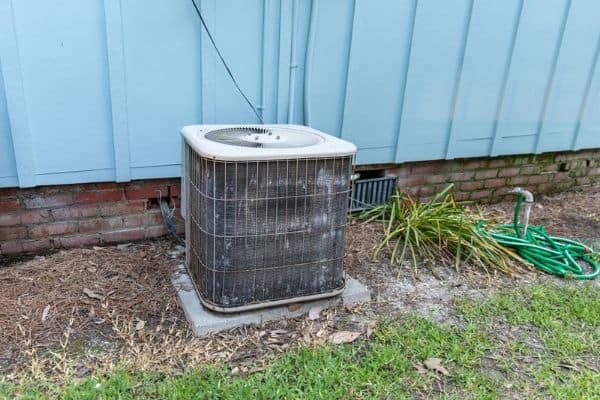What Is a SEER Rating?
All air conditioners are required to have a Seasonal Energy Efficiency Ratio (SEER) specification.
The SEER specification of an AC unit is a measure of how efficiently it converts electricity into cooling power over the cooling season (summer).
Higher SEER ratings mean better efficiency. For example, a 16 SEER AC unit is more efficient than a 15 SEER unit. Therefore, the 16 SEER air conditioner can provide the same amount of cooling while using less energy than the 15 SEER unit.
SEER ratings are a standardized measurement that all types of air conditioners have, including central air systems, window AC units, portable air conditioners, ductless mini-split systems, and more.
If you’d like to learn more about what SEER ratings are, check out our article here.
What Are Good SEER Ratings for AC Units?
Over the last few decades, SEER ratings of air conditioners have improved dramatically. Today, SEER ratings of 13 to 14 are the minimum SEER ratings you will see on the market.
Although 13 and 14 SEER system ratings are excellent in their own right, they are the minimum on the market. Anything higher than that could be considered “good.”
For example, by comparing the power consumption of a 13 SEER to a 20 SEER unit, you will see that the 20 SEER consumes 35% less energy use than the 13 SEER unit through a simple comparison of the SEER ratios:
1-(13/20) = 35%
As you can see, a 20 SEER AC unit provides a much lower power consumption than a 13 SEER air conditioner. That said, 20 SEER is a fantastic rating, and – somewhat surprisingly –efficiency ratings on some types of air conditioning units can reach over 30 SEER! As you can imagine, higher SEER units have much lower operating costs.
Most HVAC professionals will tell you that any SEER rating over 15 SEER is considered “good,” while 13 and 14 SEER are the bare minimum ratings required by U.S. law. 15 SEER and above are more energy-efficient and, as a result, perform much better in the long-term.
Central Air Conditioner SEER Ratings
Central air conditioners vary in size from 0.5 to 8 tons for residential buildings. On the commercial market, you will likely find central AC units with SEER ratings of up to 21.
While SEER ratings for central AC units in the 30s are possible, due to the duct-related losses in cooling and airflow, the “real” efficiencies tend to be 12-20% lower than the specified ratings.
Central AC units with higher SEER ratings (above 15 or 16 SEER) have either 2-stage or variable speed compressors and variable speed blowers to achieve these superb efficiencies.
Lower SEER systems typically have single-stage compressors and fans, meaning they are either on or off and cannot throttle the amount of cooling they provide to achieve more efficiency.
Window AC Unit SEER Ratings
Window air conditioning units and room air conditioners usually don’t advertise their SEER ratings. However, they always have an energy efficiency ratio, typically located near the bottom middle of the yellow Energy Star energy guide tag.
Window AC units, on average, range from 11.5 to 13.5 EER ratings. As stated previously in this article, EER is not the same as SEER, so you shouldn’t compare SEER vs. EER or vice versa. Only compare EER to EER and SEER to SEER.
Ductless Mini-Split SEER Rating
The maximum SEER of a ductless mini-split unit is 42 SEER. As of today, Carrier – a leading HVAC manufacturer – is the only brand to have achieved this rating.
Most ductless mini-split air conditioners sold are in the high 20s to low 30 SEER ratings.
Ductless mini-split heat pumps can achieve such high SEER ratings because they provide cooling directly to the room and experience no losses through ductwork.
Air Source Heat Pump SEER Rating
Air source heat pumps are HVAC systems that can provide both cooling and heating by adding the capability to operate the vapor-compression refrigeration cycle in reverse.
They have similar SEER ratings as central air conditioners, ranging from 14 SEER up to 20+ SEER.
Why Are SEER Ratings Important?
The main thing you need to know about SEER ratings is that lower SEER ratings are less efficient, and higher ones are more efficient.
Air conditioners with lower SEER ratings will use more electricity to cool your home than higher efficiency ones of the same size, which will cost more on your power bill.
Energy efficiency is important, especially for air conditioning units, since there are so many AC units spread around the country. The sheer amount of AC units was one of the contributing factors to establishing the SEER standard in the first place.
How Do You Find the SEER Rating of an Air Conditioner?
Before we dive deeper into why SEER ratings are important, you should know how to identify the SEER rating of an AC unit.
Finding the SEER rating on any air conditioner should be very easy. If you are looking for a new air conditioner, the SEER rating is located on a packaging label and usually in the product’s name if you’re browsing online.
If you are trying to determine the SEER rating of the air conditioner in your home or business, that may be a bit more difficult. If you can find a product label, or nameplate, on the AC unit, the SEER rating should be stated on that.
If you don’t see the SEER rating on the air conditioner itself, find the model number and type it in online. If that doesn’t yield any results, call the manufacturer’s customer support.
If your current air conditioner is working fine and is relatively new (less than ten years old), you should not be too concerned about its SEER rating. Replacing an air conditioner just to gain a higher SEER rating is typically not cost-effective.
However, when it comes time to replace it because it has reached the end of its life, you might be interested in the SEER rating so you can get a better SEER rating on the new AC unit.
SEER Ratings Can be Used to Determine Energy Usage
Since SEER ratings for air conditioners are all about efficiency, most homeowners might be wondering how much electricity they use and the cost.
To figure this out, you’ll need to know the SEER rating of the AC unit, the cooling output in British thermal units per hour (BTU/h), the number of days per year you expect to use the air conditioner, the cost of electricity from your utility company, a calculator, and a bit of patience!
Don’t worry! The calculations are not complicated, just simple multiplication and division- no tricky algebra or calculus is required.
To start, find the air conditioner’s cooling output and SEER rating.
Let’s say it’s 5,500 BTU/h and 15 SEER for this example. Next, you will want to estimate the number of days it’s used in a year. Let’s say that’s four months which is about 120 days.
You’ll also need an estimate of how many hours per day it will be used. We’ll say it’s 10 hours per day for this example since it’s generally cooler when the sun goes down.
With these three numbers (5,500 BTU/h, 120 days, and 10 hours/day), we can perform the following calculation to find the BTUs used per year:
5,500 BTU/h X 120 days X 10 hours/day = 6,600,000 BTUs per year
Finally, we need to convert that BTU/year number to watt-hours (Wh) per year:
6,600,000 BTUs per year x 15 BTU/Wh = 440,000 Wh per year
There you have it, you calculated the yearly energy usage of an air conditioner!
If you want to determine the annual power using, you need to divide the AC unit’s cooling output by the SEER rating (15).
5,500 BTU/h 15 SEER = 367 watts or 0.367 kilowatts (kW)
SEER Ratings Can be Used to Calculate Annual Electric Costs
To find your estimated annual cost for the air conditioner, take your energy cost per kWh and multiply it by the kilowatts you previously calculated (0.367 kW).
Let’s assume an electricity rate of $0.23 per kWh for this example.
0.367 kW$0.23 per kWh = $0.084 per hour
Finally, to determine your total energy cost per year, multiply the hours running per day (10 hours per day) by the days used per year (120 days) and the above cost per hour ($0.084 per hour).
10 hours per day 120 days $0.084 = $100.80 per year
As you have seen, this efficient air conditioner with a 15 SEER rating and 5,550 BTU/h cooling capacity costs just over $100/year to operate! How’s that for energy savings?
How Much More Do Higher SEER Ratings Cost?
Since air conditioning units have so many other factors, like their type and size, it is recommended to compare SEER ratings of AC units of the same type and size when comparing costs.
For example, here are some average prices for a 4-ton central air conditioner with various SEER ratings:
- 13 SEER – $1,200 to $1,800
- 15 SEER – $1,700 to $2,600
- 17 SEER – $3,500 to $5,000
- 20 SEER – $5,000 to $8,000
As you can see, higher SEER units are more expensive, but they will lower your energy bills so you will see cost savings in the long run.
What Should You Look For In an AC Specialist?
If you require support in determining the best SEER (seasonal energy efficiency rating) for your new AC system, our HVAC specialists are ready to help and are awaiting your call.
We can assess your home and provide a personalized recommendation based on your climate zone, home’s natural shade, the size of your home, and your budget to optimize your energy savings.
We can also use the Manual J calculation to recommend the best-size AC unit for your home. Ultimately, it’s best to hire one of our seasoned pros to run these calculations and evaluate your unique situation. From there, we’ll be able to advise you on the best unit for your particular needs.









